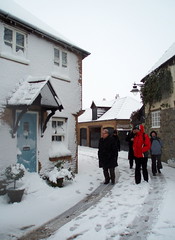 Poundbury
Poundbury, the Prince of Wales' model urban development on the edge of Dorchester, is as stimulating as it is controversial. Go there with a group, and everybody will comment differently about the place. I was there recently as part of a team led by
Willie Miller Urban Design for the
Prince's Foundation for the Built Environment. It was a fascinating experience.
Poundbury is an extension to the small county town of Dorchester. It is being built on farmland by the Prince of Wales and his team of designers - planning began in the late 1980s, with construction starting in 1993. Building is still going on, and is planned to continue until 2025.
part of a distinguished tradition
The Prince's representatives themselves describe the development as an exemplar. It is in fact the latest in a distinguished tradition of planned model settlements across the UK. From the late eighteenth century
New Lanark on the River Clyde, nineteenth century
Saltaire near Bradford, through early twentieth century
Port Sunlight,
Letchworth and
Gretna - and others besides - these settlements represent attempts by their developers and designers to create a utopian model of urban development. Each is a physical design response to particular social concerns at the time - such as education, better housing for workers, and access to open space and a green environment.
In the case of Poundbury, the concerns could be described as reducing our reliance on the private car, better placemaking, and creating 'mixed use' urban development. In other words not just housing, or offices, or industry - but providing homes, jobs and community facilities all in one neighbourhood which is small enough to get around on foot.
Poundbury also seeks to promote a specific architectural look or style, based on neo-vernacular, traditional building design from pre-Modern days. (It is around this
Vision of Britain that much of Poundbury's controversy is centred - controversy that is amply covered elsewhere on the web. Just google
Poundbury architecture and you'll soon see some heated debate.)
I don't want to get involved in a debate about the architecture. But in terms of urban design, Poundbury is a fascinating case study at a number of levels - the creation of pedestrian-friendly streets, the relationship between parking, gardens and density, and the sheer attention to detail that is apparent wherever you look. Take a look at the slideshow below and you'll get a flavour of what I mean.
 Poundbury, the Prince of Wales' model urban development on the edge of Dorchester, is as stimulating as it is controversial. Go there with a group, and everybody will comment differently about the place. I was there recently as part of a team led by Willie Miller Urban Design for the Prince's Foundation for the Built Environment. It was a fascinating experience.
Poundbury is an extension to the small county town of Dorchester. It is being built on farmland by the Prince of Wales and his team of designers - planning began in the late 1980s, with construction starting in 1993. Building is still going on, and is planned to continue until 2025.
Poundbury, the Prince of Wales' model urban development on the edge of Dorchester, is as stimulating as it is controversial. Go there with a group, and everybody will comment differently about the place. I was there recently as part of a team led by Willie Miller Urban Design for the Prince's Foundation for the Built Environment. It was a fascinating experience.
Poundbury is an extension to the small county town of Dorchester. It is being built on farmland by the Prince of Wales and his team of designers - planning began in the late 1980s, with construction starting in 1993. Building is still going on, and is planned to continue until 2025.